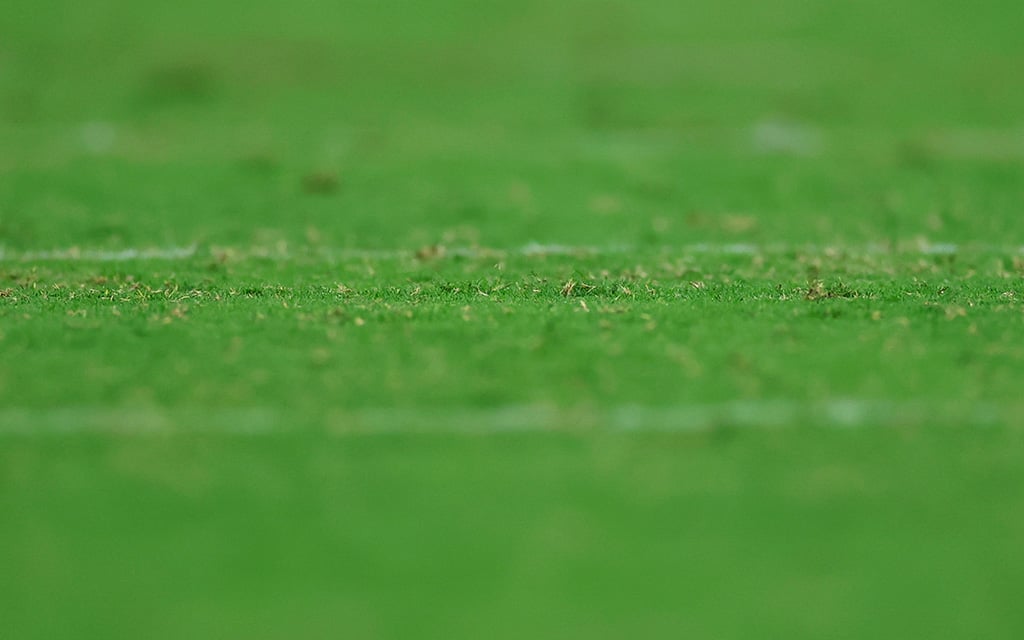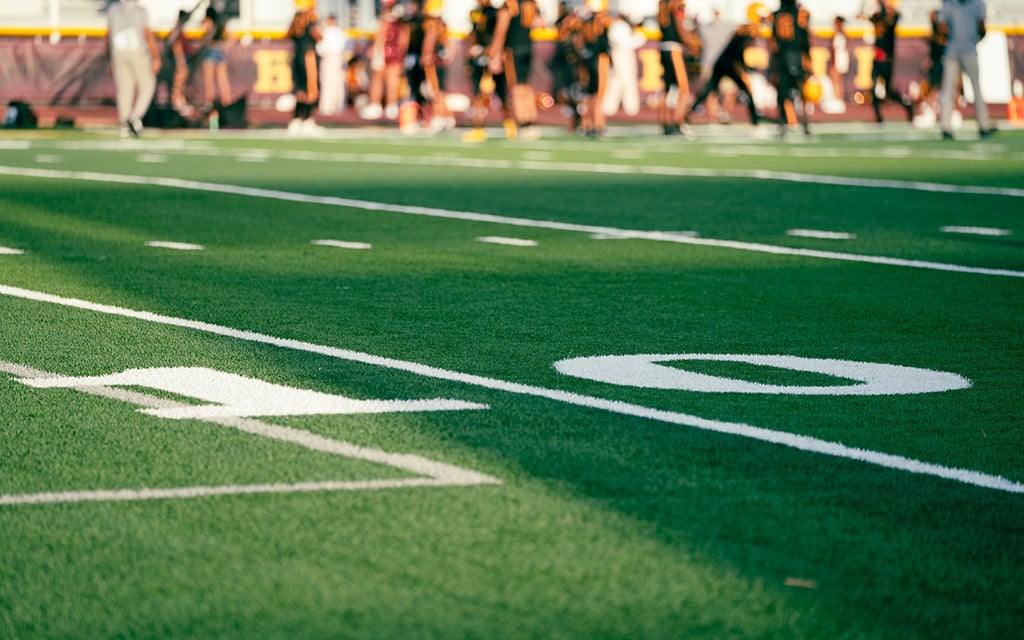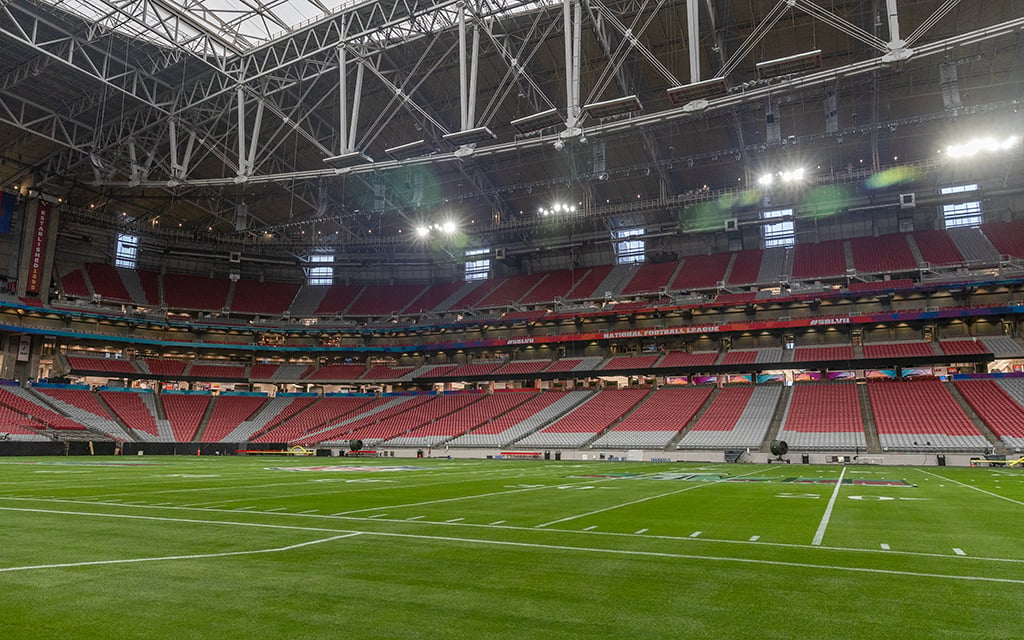PHOENIX – The NFL has always claimed that it prioritizes the health and safety of its players above everything else. Yet, as the 2024 season begins Thursday night, a topic that has concerned participants for years continues to linger.
The field-surface debate seems to grow louder with each passing season, sometimes with each passing down. Gruesome lower-extremity injuries appeared to consistently transpire on synthetic turf surfaces more often than natural grass in 2023, according to data from Sharp Football Analysis.
Among the group of injured players, none was more notable than New York Jets quarterback Aaron Rodgers, who tore his Achilles tendon four snaps into his Jets’ debut on Sept. 11. His injury occurred at New Jersey’s MetLife Field, which uses a synthetic turf surface.
Prior to the 2023 season, MetLife Field switched the field surface from UBU Speed S5-M to FieldTurf Core HD. The previous synthetic turf surface had been a point of contention for players dating back to the stadium’s opening in 2010. The new field surface was noted to have a more “natural feel.”
In the aftermath of Rodgers’ injury, the NFL players union voiced its concerns, urging the league to require natural grass surfaces at all stadiums.
“Our anecdotal sense is it’s overwhelming that players prefer to play on grass rather than turf,” NFLPA senior communications manager Brandon Parker said. “And a day or two after Aaron Rodgers tore his Achilles on MetLife field, our executive director (Lloyd Howell) came out and just said, ‘This is another example of why we need to look more into having better grass or better field surfaces in general.’”
Rodgers isn’t the only player whose season was wiped out after suffering a significant lower-extremity injury in 2023. This list includes Minnesota Vikings quarterback Kirk Cousins, who recently signed with the Atlanta Falcons, and Miami Dolphins defensive end Jalaen Phillips. Like Rodgers, their injuries transpired on a turf field surface.

New York Jets quarterback Aaron Rodgers grimaces in pain after tearing his Achilles tendon on MetLife Stadium’s turf field during the 2023 season opener. (Photo by Michael Owens/Getty Images)
This prompted the NFLPA to recently add a section regarding field surfaces on the annual team report cards that players fill out at the conclusion of each season.
“We (NFLPA) had a question in our annual team report cards about a preference of grass over turf,” Parker said. “And 92% of the players said that they prefer grass over turf, and we had almost 1,800 players participate in that survey out of roughly 2,100 players across the league.”
Despite the growing number of injuries, the NFL has waved off the notion that stadiums utilizing turf field surfaces are the root cause of these types of injuries. The league doubled down on its stance in February, stating that the injury rate differential between turf and grass surfaces during the 2023 season (0.001) was the lowest it has been in the past seven years.
Heading into the 2024 season, nothing has changed in resolving the field surfaces issues. The question remains: if a generational player of Rodgers’ caliber getting injured on a turf field surface won’t force the NFL to change, what will?
History of field surfaces
Half of NFL stadiums currently have natural grass; the other half have some type of artificial turf. The Arizona Cardinals, for instance, play on natural grass at State Farm Stadium in Glendale. The Green Bay Packers and Philadelphia Eagles are the only teams that play on a grass and turf hybrid field surface.
Originally, all football games were played on natural grass field surfaces. A constant drawback of grass is that maintaining it for long periods of time is difficult due to repeated usage and changes in weather climates.
This led to the creation of the first synthetic turf known as Chemgrass, or AstroTurf, in Houston, Texas, at the Astrodome in 1966.
The composition of AstroTurf starts with a base made up of gravel, asphalt or concrete. Then a shock-absorbing pad is placed on the base. Finally, the top layer is a mixture of polyethylene (plastic) fibers and turf.
AstroTurf became more widespread in multi-use stadiums during the 1970s and 1980s because of its durability and ability to remain in playing condition. This made it easier for the stadium to be altered for different events without the risk of the field surface being damaged.
However, an issue that became more apparent by the 1990s was AstroTurf and other synthetic turf surfaces appeared to put players at greater risk of injury.
“Not only was the turf surface bad, it felt like I was playing on top of concrete or steel,” said retired NFL player and coach Emerson Martin Jr. “There was no cushion to the surface. There were no pellets. You had to wear a flat shoe or tennis shoe because it was really like playing on a hard surface. If you wore cleats, you’d tear up your knees because they got caught up in the turf.”
The technology involved in creating synthetic turf surfaces has evolved significantly over time.
ESPN in October detailed how modern turf surfaces use fibers and infills intertwined within the turf. These materials are commonly seen when a player drags his feet on the turf field surface.
This was implemented to simulate the effects of grass and dirt on a grass field surface. In addition to this, pads are also placed underneath the turf to soften the impact when a player hits the ground.
A notable technological advancement within the past five to six years that has helped maintain grass field surfaces is called sod on plastic.
“Sod on plastic involves putting grass down on plastic and you top dress it,” West Coast Turf sales manager Joe Traficano said. “The plastic pushes the roots up through the soil which makes the grass intermingle or intertwine itself. It becomes a pliable, unbendable mat of grass that’s removed and harvested. We use sod on plastic for fields that are hosting sporting events in a short time frame like the Super Bowl last year. It can then be played on right away if needed, but usually it’s put in three weeks before the event.”
Many players have advocated for the use of sod on plastic and sod-based grass to help maintain the playing condition of grass fields. This is especially useful in maintaining grass fields in colder climates.
However, when the technology is used in combination with turf the results aren’t ideal as it impacts the feeling of the field surface. This issue arose in the days leading up to this year’s Super Bowl, with San Francisco 49ers coach Kyle Shanahan stating that the UNLV practice field was “too soft.”
“The experts agree that when you’re putting a grass sod field over existing turf, you’d rather put a hard plastic cover over the turf before putting the sod down,” former NFLPA President JC Tretter said in February at the NFLPA’s “state of the union” press conference.
“My understanding is that’s not what happened, which is adding to the issue of this softer field. And leading up to (NFL commissioner Roger Goodell’s) press conference on Monday, we said it’s OK because the field’s playable. We talked about last week that we need to raise the level to make both surfaces high quality, and then a week later you’re saying it’s OK because it’s playable? Playable is not the same standard as high quality.”
The NFLPA hopes that the developments that have been made with grass and turf field surfaces will lead to a safe, sustainable field surface that all parties can find acceptable.
“The numbers and stats show that grass is good, but we also want it to be good quality grass,” Parker said. “You have situations like the (Washington) Commanders’ field where they have a grass field, but there’s been a lot of issues because it’s not well-maintained. So, there’s obviously standards that we want when it comes to the grass. And that’s what we’re working towards now with the league.”
Difference in injuries between the field surfaces and how the injuries occur
While injuries can happen on any field surface, recent studies have further strengthened the idea that players are more susceptible to injuries on turf field surfaces. Last September, NBC News examined data from Sports Info Solutions to see the injury counts of each stadium from 2017-2022.
The data revealed that “7 of the 10 stadiums with the highest number of injuries per game on average” have synthetic turf. This is a stark contrast from the “7 of the 10 stadiums with the least injuries” as those stadiums use grass.
“Sports injuries are not black and white,” OrthoKansas director of sports medicine Dan Lorenz said. “Each injury has different potential reasons as to why they’re occurring. One study in 2018 found a trend with 16% more injuries being attributed to turf versus natural grass. That study projected about 300 less general injuries would have happened had they played on grass instead.”
ESPN also looked at the rate of injuries in October, using safety statistics formulated from the Field Surface Safety and Performance Committee, which is required by the collective bargaining agreement to meet twice a year. The NFL and the NFLPA select experts to work alongside medical officials to examine potential lower-extremity injuries that are a result of playing surfaces. They have specifically investigated non-contact injuries.
The results of their research have shown that in the past 11 years the injury rate is higher on turf. The only outlier found was in 2021 when the injury rates on both surfaces were nearly identical (.042 per 100 plays on turf, .041 on grass).
“You look at some of the lower-extremity injuries like an ACL, about 75% of them are typically non-contact,” Lorenz said. “What usually happens is a high deceleration of a plant cut or a sharp turn causes the ACL to tear. You also have the Achilles, which are typically injured when your heels are off the ground, or your toes are buried into the ground. Then if you make a quick movement and your Achilles ruptures. Again, though, there are many different reasons as to why these injuries occur.”
Looking beyond the numbers, what exactly makes a lower-extremity injury more likely on turf rather than grass? Grass is a softer, more malleable surface which makes it easier as players are cutting or turning when they run. Turf is a hard, stiffer surface which forces players to plant their feet harder when making a change in direction or movement.
This can cause cleats to become stuck, thus leading to some part of the leg buckling down or contorting in an unnatural way that leads to an injury.
“Grass is less straining on your body,” New England Patriots linebacker Terez Hall said. “You do a little bit more slipping on grass, but I just feel like it has more give when you’re moving on it. You don’t have to cut extremely hard, or your foot doesn’t get stuck in the ground when you’re tackling someone on grass. It’s safer to play on in that sense.”
Other factors contributing to issues with different field surfaces
Different field surfaces aren’t the sole culprit in lower-extremity injuries. External factors exist, although the impact varies based on whether the surface is grass or turf. The factors include types of cleats, weather conditions, and training regimens used in practices.
On multiple occasions the NFL has argued the reasons mentioned above create unpredictable complications with the injuries associated with varying field surfaces. However, none of the factors has drastically altered the state of a turf or grass field to expedite an injury.
As mentioned earlier, new innovations like sod on plastic helps offset the wear and tear of colder climates.
There haven’t been practice drills, training regimens, or plays that provide sufficient evidence of an uptick in injuries. Even if there were, coaches such as Atlanta Falcons special teams coordinator Marquice Williams will always be open to altering practices to protect the health and safety of players.
“When injuries happen, it’s usually because of an overuse of a muscle or a ligament,” Williams said. “As a special teams coach, you must be mindful of how much speed and space you’re using. For example, if we are working a kickoff play, sometimes it’s not good to work the full kickoff with multiple reps.
“Instead, you can break it up into different pieces, teach it in two to three parts by having a jog tempo, a walkthrough tempo, and a speed tempo. Myself as a coach, I must be mindful of that. We try to practice on grass all the time, but there’s days we must practice inside. I may modify the practice on turf just because of the toll it has on their joints.”
The league’s belief is cleats could be a major contributor in an increase of non-contact, lower-extremity injuries.
In early September, RunRepeat published an article detailing the variety of different cleats used in all levels of football in recent years. More than 10 brands of cleats are used on average in football.
“There’s a lot of different variables with playing on different surfaces,” Williams said. “Our guys must be professionals when preparing for games. They can wear specific cleats based on if the field is turf or grass.
“If we’re playing in rain, snow, or colder conditions they might have to switch up the type of cleats worn to make certain cuts, movements, and changes in direction needed to optimize their ability as a professional athlete. I think our athletes (Falcons players) are in control of the surface they play on, but they must do a good job of preparing by wearing the right gear and the proper attire when they play on grass or turf surfaces.”
According to Runrepeat, Nike produces the most utilized cleats. On average, 48.5% of NFL players use Nike cleats. The second most is Adidas, with an average of 37.7% being used.
The NFL simply uses external factors to deflect blame for the ever-growing list of injuries happening on synthetic turf field surfaces compared to grass, according to its critics. The NFLPA is open to exploring alternative options to eventually resolve the field surface controversy.
“We’ve worked with the league to look at different things impacting field surfaces,” Parker said. “Whether that’s different types of cleats, practice drills, or equipment because that’s what players are using in preparation for games. While the field surfaces play a big role in injuries, there’s other things that come into play that we’ve considered in addition to getting better playing surfaces.”
Critics say NFL is motivated by more than player safety

The natural field at State Farm Stadium, home of the Arizona Cardinals, represents one of the 16 NFL stadiums that still use grass surfaces. (Photo by Brooke Sutton/Getty Images)
Regardless of the data and opinions from the players, the NFL refutes the idea that synthetic turf surfaces have created more issues than grass. Why exactly is that?
“Everything comes down to money, which is often the case when you’re dealing with management,” Parker said. “They (NFL) also talk about stadiums not being just for sports anymore. Concerts, different sports, and other events are hosted in stadiums. The league wants to create the most profit and have been willing to invest in different industries. Why not invest more resources for your actual employees that are going to work every day and are putting their bodies on the line for the team?”
Outside of when new facilities are built, the playing surfaces of stadiums don’t change often. The last team to change field surfaces was the Tennessee Titans, with Nissan Stadium switching from natural grass to a “monofilament, Matrix Helix Turf with organic infill” prior to the start of the 2023 season.
While announcing the change in early 2023, the Titans stated their reason for switching from natural grass was to reduce the number of player injuries.
The NFL relies on alternate events as a source of revenue during the offseason as there aren’t games to be played until preseason in August. Venues such as State Farm Stadium in Glendale host up to 200 events per year.
The number of events held will increase in 2026 with the NFL making a formal announcement in February that multiple FIFA World Cup games will be played in NFL stadiums. This includes stadiums that utilize turf such as MetLife Field and Gillette Stadium that will switch out the turf for grass solely for the World Cup.
“The NFL has said it themselves it comes down to money,” Parker said. “We are seeing that with the World Cup coming to the U.S. in the next couple of years. The soccer teams want to play on grass. For these stadiums to be a host site for these World Cup games, the NFL has said they’re willing to change the fields to grass just for those games, but then change it right back to turf, if that’s what they have, for football.”
The league’s main reason for resisting change is based on revenue and expenses. So what exactly might convince the league to eliminate synthetic field surfaces?
In the past the NFL has changed policies or procedures if a highly notable player is injured. Rodgers went down and the league didn’t flinch. Another big name might evoke a different response.
“If I tear my Achilles or something in my knee, it’s viewed differently than someone like Saquon Barkley, Aaron Rodgers, or Odell Beckham Jr,” Hall said. “It’s a big difference when someone who has a big following and is notable goes down because he’s more important to the brand itself.
“Remember what happened with Tom (Brady)? With the roughing the passer calls, guys were hitting him below the knee and just trying to sack him. The rule changed the following year (2023). Or back in 2005 when T. O. (Terrell Owens) got hit with a horse collar tackle and broke his ankle, they changed the rule. It’s always going to need to be the superstar athletes of the league getting injured to bring true attention to these issues.”
Change could happen through extreme measures such as multiple players across the league sitting out of games or refusing to sign new contracts with teams. The issue with this scenario is not all players have the financial stability to stop playing games altogether.
“I didn’t have the luxury of being able to turn down someone because of the type of field surface,” free agent tight end Ian Bunting said. “If a team was trying to sign me, I always am like ‘absolutely let’s go.’ I was an undrafted guy, constantly on the practice squad, so I could never be picky with the opportunities I had.”
The status quo
The 2024 season is here, yet the field surface controversy remains unresolved.
All the data and surveys indicate grass is the preferred field surface and is slightly safer. Players, coaches, and the NFLPA continue to push for turf being abandoned altogether, even if extreme measures must be taken for change to happen.
A potential resolution between the league and the players association is a hybrid surface composed of grass and turf. There could also be different types of turf that could be explored.
“We don’t want to make it seem like it’s just a matter of it has to be grass and no turf is good to use,” Parker said. “We want to make sure whether it’s a grass, turf, or hybrid surface that it’s maintained properly. If we’re going to have these conversations, there has to be a willingness from management to invest in what is needed to maintain the right field surface.”




